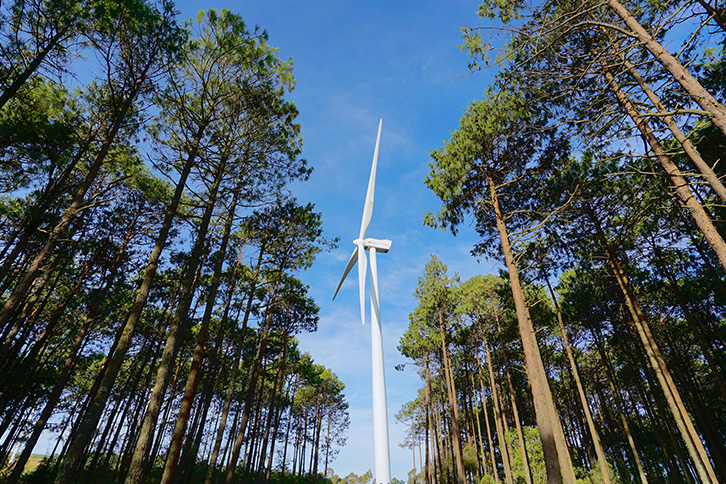News
2024-06-15 09:45:00.0 - 2024-06-15 09:45:00.0 UTC +02:00Iberdrola obtains final environmental authorisation to build Portugal's largest wind farm
- The infrastructure is part of the Company's Tâmega hydroelectric complex in the neighbouring country.
- The new wind farm will have a capacity of 274 MW and will make use of the grid injection point already built at the Tâmega hydroelectric complex to increase the supply of clean energy.
- This project will enable greater energy security by helping to achieve independence from fossil fuels and moving towards decarbonising the economy.
Iberdrola obtained the final environmental approval from the Portuguese government to build the country's largest wind farm. The Company is thus taking a step forward in its expansion in the neighbouring country, promoting the transition towards an economic model based on decarbonisation through renewable energies and independence from fossil fuels − which will enable greater energy security and autonomy with clean and local production.
The new wind farm will have a capacity of 274 MW, equivalent to the consumption of 128,000 households, and will be built in the town of Vila Real, in Braga. It is the largest hybridisation project in the country, designed to make use of the grid injection point already built at the Tâmega hydroelectric complex, and the first to combine wind and hydro power.
The Company obtained the second and last favourable environmental authorisation for the Tâmega Eólico project. This is the so-called DCAPE (“Decisão da conformidade ambiental do projeto de execução” – Decision of Environmental Conformity of the Execution Project).
This step involves the approval by the Portuguese environmental agency, APA (Agência Portuguesa do Ambiente) of the construction project, complying with all the conditions and measures included in the favourable Environmental Impact Statement that Iberdrola obtained in March 2023.
In this way, the energy company continues with the processing of the installation. The next step will be to apply for a production licence from the Portuguese Directorate-General for Energy and Geology. Iberdrola's objective is to obtain all permits and begin construction in early 2025.
Cutting-edge technology
Incorporating wind power to the Tâmega hydroelectric complex increases the contribution of clean, cheap and competitive energy to the electricity system of these facilities and ensures the maximum amount of green energy supply originally authorised for each project, for as long as possible.
By having two technologies capable of alternating, dependence on changing environmental conditions and limitations due to possible lack of resources such as wind are significantly reduced − facilitating more stable and efficient renewable production without overloading the electricity infrastructure
Hybrid generation plants use the same grid connection point and share infrastructures, such as the substations, which in this case will require the construction of an extension that was already designed in the initial project, and the evacuation line for the electricity produced.
In addition, they are located on land that was already used for renewable generation and allow for common roads and facilities for the operation of both technologies. All this results in a much lower environmental impact than two independent plants would have had.
Coexistence with the environment
Iberdrola will implement various environmental measures on the ecosystems in the area of influence of the wind farm. Furthermore, given the proximity of both projects, some of the measures already successfully implemented in the Tâmega Electroproduction System will be continued, such as the planting of native species and actions related to forest management in the surrounding forests.
Measures that favour fauna will also continue, such as pasture plantations, plantations of species with fleshy fruits, the creation and recovery of ponds and the installation of nesting boxes for bats.
In addition to the biological and archaeological monitoring during construction, a series of Ecological Systems Monitoring Programmes (birds, bats, wolves, flora and habitats) will be implemented to control possible impacts and to define new enhanced measures.
Tâmega hydroelectric project
The Tâmega hydroelectric project is one of the largest hydroelectric projects undertaken in Europe in the last 25 years. It consists of three power plants: the Alto Tâmega Hydroelectric Power Plant, with an installed capacity of 160 MW; the Gouvães Pumped Storage Power Plant (880 MW); and the Daivões Power Plant (118 MW), the latter two will be operational from 2022.
The three plants will have a total installed capacity of 1,158 MW, which will represent an increase of 6% of the total installed electrical power in the country. The complex will be capable of generating 1,766 GWh per year, enough to meet the energy needs of neighbouring municipalities and the cities of Braga and Guimarães (440,000 households). In addition, this large renewable infrastructure will have the capacity to store 40 million kWh − equivalent to the energy consumed by 11 million people during 24 hours in their homes.
Tâmega will eliminate the emission of 1.2 million tonnes of CO2 per year and diversify production sources − avoiding the import of over 160,000 tonnes of oil per year. This project will also promote economic activity and employment in the region, since during the entire construction phase it is estimated that up to 3,500 direct jobs and 10,000 indirect jobs will be created − 20% of which come from neighbouring municipalities − through over 100 suppliers, 75 of which are Portuguese.
The Tâmega Hydroelectric Complex is one of the largest energy initiatives in the history of Portugal, with a total investment of over €1.5 billion and an installed capacity of 1,158 MW, as well as an energy reserve of 40 million kWh − equivalent to the energy consumed by 11 million people during 24 hours in their homes.







